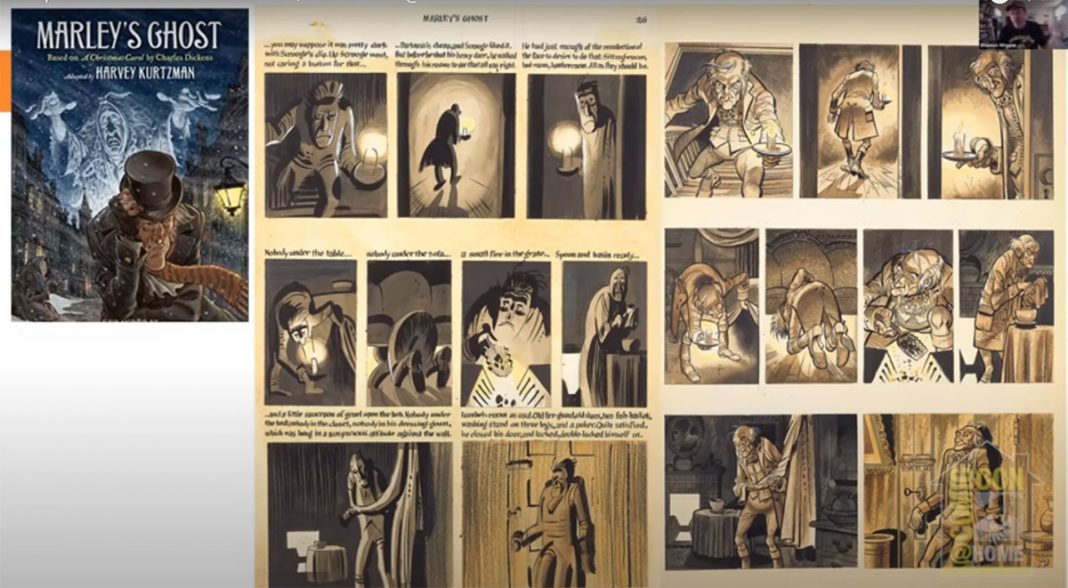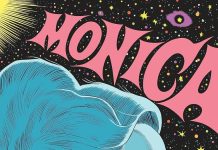If you bring a master’s work to fruition, might that also make you a master? The fascinating ComicCon@Home 2021 panel “Graphic Novels: Lost and Found” brought us tales of creators pouring all their efforts into works that remained hidden for years, incomplete or unseen, and fellow creators and publishers who helped those books see the light of day.
Panelists Gary Groth, Shannon Wheeler, Sean Michael Robinson, and Carson Grubaugh gathered virtually with moderator Rob Salkowitz to discuss their participation in stewarding these now “found” graphic novels to publication. In two cases, the modern creators actually finished the novels themselves in the spirit of the original creator’s vision.
Harvey Kurtzman’s A Christmas Carol adaptation
New Yorker cartoonist and graphic novelist Wheeler was part of a creative team, including co-author Josh O’Neill and artist Gideon Kendall, who took the legendary Harvey Kurtzman’s concept of Marley’s Ghost and completed it. Wheeler cited O’Neill as lead author, with himself as editor and project manager, and raved that Kendall was like a “reincarnate of Kurtzman,” with the chops to execute on the final art.
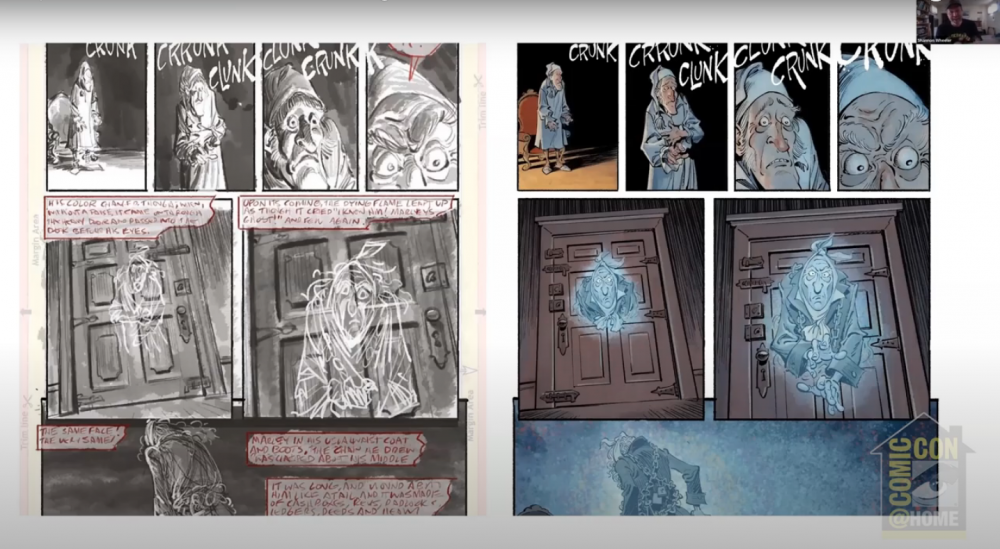
Kurtzman had adapted Charles Dickens’ A Christmas Carol into extensive graphic notes. According to Wheeler, Marley’s Ghost could potentially have been the first graphic novel (begun in the 1950s), but publishers rejected it at the time, not respecting cartooning as worthy of a book for adults. Kurtzman did not pursue publication or completion further before his death. ComiXology’s Chris Mosher later took an interest in the draft and the creative team to complete it was assembled.
Today, Kurtzman is respected as a huge influence on American comics, most notably for his work on Mad Magazine. “It’s the sort of work that has influenced everybody since,” Wheeler remarked. “All the cartoonists I know have drawn something—whether intentional or not—from Kurtzman.”
The creative interplay of Kurtzman and Dickens in Marley’s Ghost struck Wheeler as similar to that of the Beatles’ Lennon and McCartney, seeming diametrically opposed—with Kurtzman efficient and Dickens sprawling—yet “it oddly works together in a way you don’t expect.” The completed Marley’s Ghost was published digitally via ComiXology in 2018, winning an Eisner.
Dave Sim’s exploration of Alex Raymond’s death (and art)
Robinson, a publisher and creator, and Grubaugh, an artist and teacher, brought another lost graphic novel called The Strange Death of Alex Raymond to completion, this one from a still-living creator, Dave Sim. Moderator Salkowitz shared a quick summary of its origins: “[It] began as an investigation into one of the enduring mysteries of comicdom: the mysterious circumstances surrounding the death of cartoonist Alex Raymond. And [Sim] used this as a springboard to talk about a lot of the technical details of art, and then it became a platform for theories of synchronicity and art history.”
Sim is known in the industry as, among other things, an influential artist and entrepreneur who self-published, wrote, and drew 300 issues of the series Cerebus from 1997-2004. Both Robinson and Grubaugh had taken an interest in Sim’s early pages of Strange Death that had appeared in the back pages of Sim’s self-published comic Glamourpuss. Both connected with Sim and became involved in his efforts to make the work into a full graphic novel.
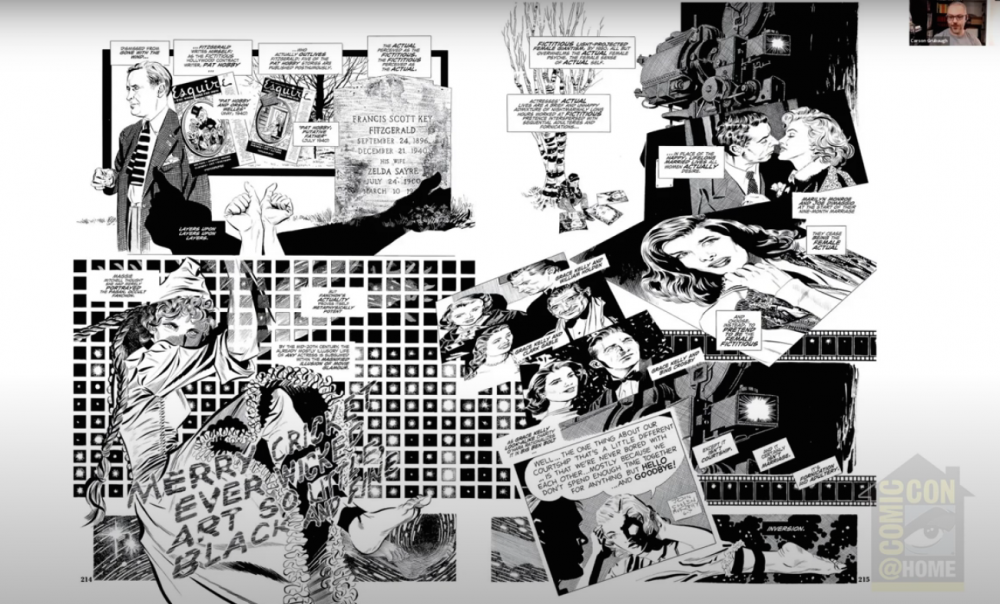
Sim’s wrist issues left him unable to continue drawing at the pace he wanted. Grubaugh took on the weighty task of drawing in the style of Sim (under Sim’s direction), who was in turn attempting to draw like Al Williamson, “at the peak of photo-realistic comic art.” Grubaugh enjoys mimicking styles, but noted that this style was especially challenging: “I’m trying to mimic what Dave looks like mimicking Al Williamson!”
Sim unexpectedly dropped out of the project after over 250 pages and a disappointing Patreon first volume response. Grubaugh then asked if he could take the book to completion on his own, with Robinson still serving as publisher, and Sim agreed. Grubaugh and Robinson’s dedication means that The Strange Death of Alex Raymond will appear in bookstores in mid-August!
A book by Barry Windsor-Smith, 35 years in the making
Groth, publisher at Fantagraphics, shared the surfacing of two other books, one by a recognized living master and one by an unknown whose drawings were discovered posthumously. The acclaimed Barry Windsor-Smith, known for his work on Conan, Daredevil, X-Men, and other titles, began work on a graphic novel called Monsters in 1985, then worked on it continuously over 35 years (in between other projects). It began as a Hulk origin story and faced some pushback from Marvel. Windsor-Smith then withdrew it from Hulk and decided to rework it as an independent story.
According to Groth, the story evolved to feature a young man named Bobby Bailey who enters a recruitment office. The U.S. government decides to conduct genetic experiments on him to turn him into a super-soldier. The story takes place from 1945-1964 and features themes of familial trauma and scary aspects of the US government.
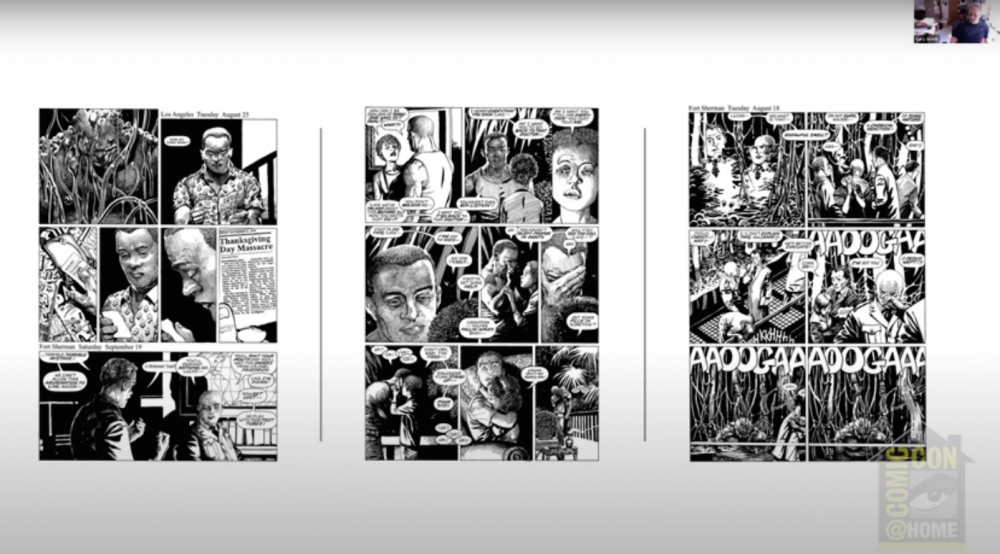
Groth said, “I think [Windsor-Smith] put everything he had into this story, everything he learned drawing comics over the last 50 years. The craft is astonishing. I think someone could do a PhD just on balloon placement. […] For a work that’s been done over 35 years, it’s remarkably seamless.” Monsters was published by Fantagraphics this April. It must be amazing for Windsor-Smith to finally see his labor of love appear after so many years.
1800 pages of cartoons from an unknown shipping clerk
Groth also discussed the unearthing and upcoming publication of the work of an unknown artist named Frank Johnson, who lived from 1912 to 1978, and secretly drew 35 notebooks worth of comics, over 1800 pages! He worked as a shipping clerk and blues musician, and his wife only discovered the notebooks upon his death. Two editors (in the art world themselves), Keith Mayerson and Chris Byrne, brought the work to Groth’s attention.
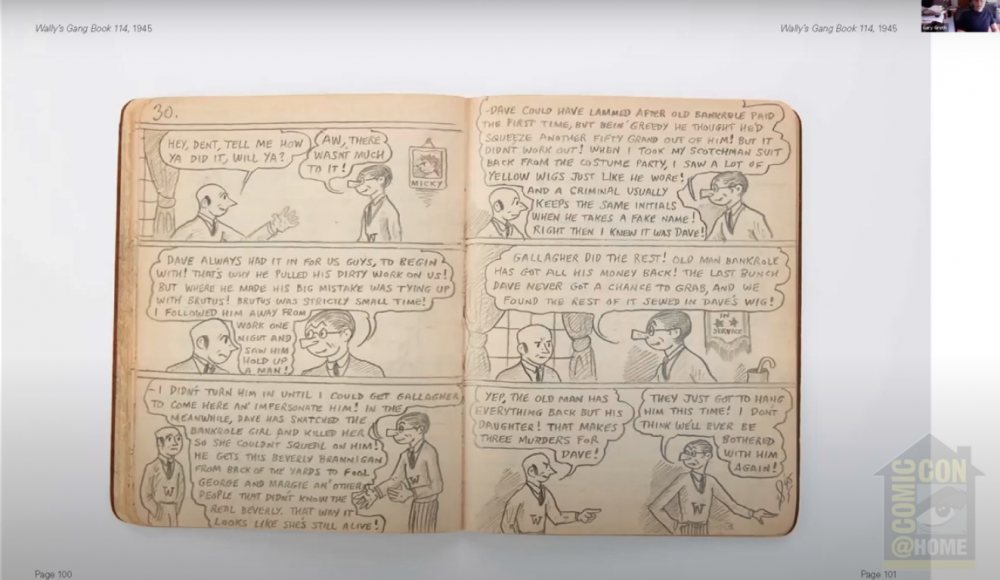
The comics aren’t continuous. They feature what Groth describes as funny and amateur strips featuring drunks, crime stories, romances, and hijinks. One of his main strips was called “Wally’s Gang.” Fantagraphics is distilling them down to the best 800-900 stories, to be called Wally World. They plan to release them in two volumes, with the notebook pages and pencil sketches displayed as they might appear if a reader were to flip through the originals. The first is slated for the end of 2022, and is a true “lost” work.
There is a running theme here of new creators and publishers as historians and collaborators, moving toward becoming giants in their own right. The collaborators were modest about their contributions, but to me, they are the unsung heroes of these works, taking up the baton. Hearing these stories makes you appreciate just how hard—and how long—creators work for you to hold a single graphic novel in your hands.
Check out the full panel here.
Miss any of The Beat’s earlier ComicCon@Home coverage? Find it all here!


